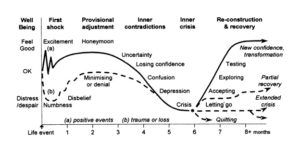
by Rick Stomphorst
Learning begins prior to joining the new firm or staring the new role. Your personal learning meter should be running from the moment you learn you’ve landed the job.
After Your Start-Day
A different set of learning tools become available once you have officially started, although, it will help you if you can obtain these prior to starting.
- Recent staff and/or client surveys or focus group results
- Product focus groups and whitepapers
- Key interfaces to the outside. E.g. Sales, support and purchasing staff. The objective is to determine how they view problems at the fringes of the organization. Plan to engage them.
- Select an important process to examine departmental interactions and efficiency. Is the process documented?
- Select an important recent decision, then investigate how it was arrived at.
- Getting in People’s Faces
Speak to People – Stakeholder Connections
One first step once you’re joined is to specifically speak with (question) people with critical knowledge as they should provide the best return on your most valuable asset, your time. These people may also exist outside of the company: key clients, suppliers, distributors or ex-staff (as such, develop standard questions for external resources). You need to speak with people with different points of view, a representative sample of people, some leaders, some key hands-on staff. Find the historian, someone who has a deep understanding of the relevant history of the company.
These people become your network, which is important as you likely lack an established network at your new company.
Rinse and Repeat
It’s important to replay the same script, ask the same series of questions during each meeting. This will give you varying views on a common set of conditions. It will also prevent any one interviewee from taking over the meeting with their agenda, or having your views shaped by the first or last few interviews. This structure allows to you assess who is being forthright (or not) and/or how deep various players understanding of the business is.
Start by meeting 1:1 with your direct reports. Again, ask the same questions. Questions to your direct reports won’t obviously be the same questions you’ll ask (e.g.) a peer or supplier, but there will be overlap. A few sample questions are:
- Who are the top 3 key customers, why?
- How did your predecessor handle decisions?
- How were goals set?
- What is the organization’s strategy?
Afterwards, have a group meeting with your direct reports to learn the dynamics of the group.
I hope this gives you enough to begin framing your unique learning plan.
A Word About Passing the Probation Period
You were hired because you are smart. Your employer has a high level of confidence in you. You were the best candidate! They want you to succeed.
Here are 5 tips to help you through the employment probation period.
1. Work Longer
A good work practice is to work an extra 15-30min at the end of the day. This will look positively on you.
Consider this, invariably staff who commute a distance will be unexpectedly late due to weather, traffic, public transit delays, etc. The “banked” minutes/day balances out against the days were the trip in takes unexpectedly longer, days where you need to leave a little early, or have a long lunch. It’s a good practice to know in the back of your mind that you have “time banked”.
Related, arrive ready to work. It’s a poor practice to arrive precisely on time only to proceed to get your coffee, engage in small talk, then turn on your computer & get setup to start work.
2. Double and Triple Check Your Work
Mistakes made in the first 90 days have a greater impact on you and your fledgling tenure than when you’re a “long term” employee.
3. Admit Mistakes
We all make mistakes. Admit any mistakes you make. Mistakes are proof that you are trying.
4. Learn
Be inquisitive. You’re new. Ask lots of questions. Take notes. Learn. Doing the opposite implies you’re not interested, don’t understand or not serious.
Seek training. If the company doesn’t provide training or peers have insufficient time, seek out webinars, vendors or training videos on YouTube. For company products, ask which are the top 1, 5, or 10 products you should focus on learning. Read manuals.
5. Manage Your On-boarding
Build a 30-60-90 day on-boarding plan. Minimally, have daily or weekly plans.
<< Previous Blog | Next Blog in Series >>

by Rick Stomphorst
You were hired because you are smart. Your employer has a high level of confidence in you. You were the best candidate! They want you to succeed.
Here are 5 tips to help you through the employment probation period.
1. Work Longer
A good work practice is to work an extra 15-30min at the end of the day. This will look positively on you.
Consider this, invariably staff who commute a distance will be unexpectedly late due to weather, traffic, public transit delays, etc. The “banked” minutes/day balances out against the days were the trip in takes unexpectedly longer, days where you need to leave a little early, or have a long lunch. It’s a good practice to know in the back of your mind that you have “time banked”.
Related, arrive ready to work. It’s a poor practice to arrive precisely on time only to proceed to get your coffee, engage in small talk, then turn on your computer & get setup to start work.
2. Double and Triple Check Your Work
Mistakes made in the first 90 days have a greater impact on you and your fledgling tenure than when you’re a “long term” employee.
3. Admit Mistakes
We all make mistakes. Admit any mistakes you make. Mistakes are proof that you are trying.
4. Learn
Be inquisitive. You’re new. Ask lots of questions. Take notes. Learn. Doing the opposite implies you’re not interested, don’t understand or not serious.
Seek training. If the company doesn’t provide training or peers have insufficient time, seek out webinars, vendors or training videos on YouTube. For company products, ask which are the top 1, 5, or 10 products you should focus on learning. Read manuals.
5. Manage Your On-boarding
Build a 30-60-90 day on-boarding plan. Minimally, have daily or weekly plans.

by Rick Stomphorst
Every year about 25% of managers change jobs. Some get promoted, some laterally, and some transitioning into new companies. Virtually no one plans an onboarding strategy and as such, 75% of transitions fail to reap expected gains. “John looked so promising” but he’s “underperforming” or “not fitting in” are common complaints. In addition to the 25% of managers changing jobs yearly, it’s not unrealistic to say that company’s have a 10% staffing churn yearly.
You want to leave a positive impact during your era in the company or role, not a failed on-boarding.

Hopson Transition Curve
Have you ever studied the process of integrating yourself into a new company, or new role within your company? The vast majority would answer “no”. Compared to business books on other practices, there are surprisingly limited resources on onboarding. The result is a onboarding roller coaster ride called Hopson transition curve.
Most companies struggle with onboarding new staff or transitioning existing staff. Most will understand very little about the transition curve. Most companies are “reactive” in nature to onboarding or transition problems.
Why Study Onboarding?
Everyone can remember criticizing the new idiots at the helm (if you’re one of my ex-managers reading this, I wasn’t referring to you – you were the exception). We criticized their decisions, their tactics, their people skills, their approaches to problems. If you don’t study how to onboard successfully, you become one of those idiots, or worse, your employment is terminated.
On-boarding Management as a Differentiator
There are plenty of solid business books and university/college courses on Business Management, but surprisingly, very few on on-boarding.
Many organizations provide new hires with a short-term orientation session, in hopes to acclimatize you to their (your new) company. One company that does excel in management training is GE. The excellent book Good to Great notes that many GE trained managers have gone on to become heads of major companies. Planning and training for onboarding does work.
Like most, you learned onboarding the hard way, the sink or swim model. You learned from your successes and hopefully equally from mistakes. Much of the onboarding process we know and execute at a subconscious level, is never put into a transition plan, a transition framework. After studying the topic, my recommendation is to develop your own onboarding plan.
This is the first in a series of blog posts on the topic of Onboarding. My objective is to eliminate the valley in the transition curve.
On-boarding Definition
- Promotion, lateral move
- Acquiring staff for the first time
- Joining a new company
- Any functional change in your responsibilities
- Same role, same company, new geographical location
Prior to Your Start-Day
Learning begins prior to joining the new firm or staring the new role. Your personal learning meter should be running from the moment you learn you’ve landed the job.
There’s a number of learning tools at your disposal to aid in ramping-up before you join:
- Ask your new employer for any additional relevant documentation, for example: recent staff and/or client surveys or focus group results, meeting minutes, product focus groups, whitepapers, manuals
- Learn about the organization’s people, structure, performance (annual reports) and clients
- Google the firm, their products, their people, product reviews, etc.
- Search product reviews, blogs, and relevant Twitter accounts (i.e. follow their people, clients, suppliers, if not already doing so), Youtube, etc.
- Speak with suppliers and customers. You may circle back to these same people later on in your learning plan
- Speak with former employees (ideally from within your network)
- Speak with your predecessor or ex-staff if possible. Linkedin will find them
- Learn the company’s strategy
- Meetup with your new manager for a structured meeting
- Try the product if possible and applicable
- Use the above to being compiling your unique initial questions to start the journey once “on the inside”.
This is the first in a series of Job Transition blogs, written to help you during your on-boarding journey.
(Reference)
Next Blog in Series >>




